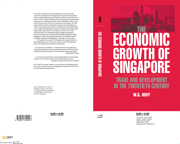Book contents
- Frontmatter
- Contents
- List of figures
- List of tables
- Preface and acknowledgements
- Abbreviations and conventions
- Geographical definitions
- Introduction
- Part One Themes and beginnings
- 1 Patterns in the economic development of Singapore, 1870–1990
- 2 Singapore in the late nineteenth century
- Part Two Development as a staple port, 1900–1939
- Part Three Staple port and rapid growth, 1947–1990
- 12 Conclusion
- Appendix tables
- Bibliography
- Index
1 - Patterns in the economic development of Singapore, 1870–1990
Published online by Cambridge University Press: 22 September 2009
- Frontmatter
- Contents
- List of figures
- List of tables
- Preface and acknowledgements
- Abbreviations and conventions
- Geographical definitions
- Introduction
- Part One Themes and beginnings
- 1 Patterns in the economic development of Singapore, 1870–1990
- 2 Singapore in the late nineteenth century
- Part Two Development as a staple port, 1900–1939
- Part Three Staple port and rapid growth, 1947–1990
- 12 Conclusion
- Appendix tables
- Bibliography
- Index
Summary
The basis for the economic development of Singapore was – and for most of its history has remained – geography. That comparative advantage can derive from ‘natural resource endowment and geographical position’ was well known to Classical economists. Geography can be thought of as a natural resource like, for example, mineral deposits in the sense that both are ‘superior’ land. The ‘natural resource’ of Singapore – an island of just 225 square miles – was location. As Alfred Marshall emphasized, geography is fundamental to any reckoning of a nation's wealth: the Thames, though a free gift of nature, ‘has added more to the wealth of England than all its canals, and perhaps even than all its railroads’. Yet few areas – even Hong Kong – can have benefited as much as Singapore from the gift of geography.
The present chapter examines the inflows of people and capital attracted by Singapore's geographical endowment and the human organization which built on it. Together, these themes allow an understanding of Singapore's development in a context of international and comparative economic growth since the settlement began in 1819.
‘It has been my good fortune’, Stamford Raffles recognized when founding Singapore, ‘to establish this station in a position combining every possible advantage, geographical and local’. There were three such advantages.
- Type
- Chapter
- Information
- The Economic Growth of SingaporeTrade and Development in the Twentieth Century, pp. 7 - 42Publisher: Cambridge University PressPrint publication year: 1994
- 1
- Cited by



